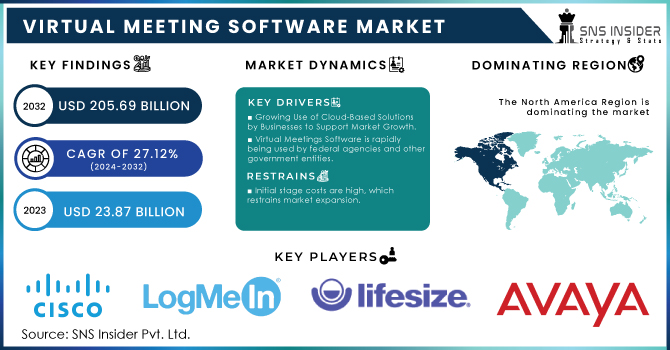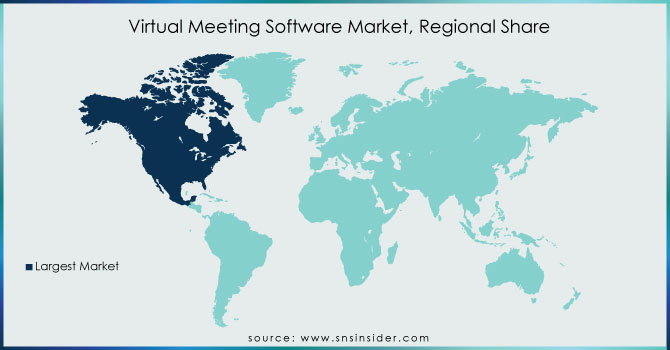Virtual Meeting Software Market Report Scope & Overview:

Get more information on Virtual Meeting Software Market - Request Free Sample Report
The Virtual Meeting Software Market Size was valued at USD 23.87 billion in 2023 and is projected to reach USD 205.69 billion by 2032 with a growing CAGR of 27.12% Over the Forecast Period of 2024-2032.
Virtual meeting software is a term used to describe the seamless, real-time collaboration among employees on a software platform. This dynamic interaction is made possible through the power of the internet, utilizing integrated video, chat tools, audio, and application-sharing systems. Moreover, individuals can effortlessly exchange data and information in real-time, all facilitated by the virtual meeting software, regardless of their physical locations. By harnessing the capabilities of virtual meeting software, employees can transcend the limitations of physical distance and come together in a virtual space. This innovative technology enables teams to connect, communicate, and collaborate as if they were in the same room, fostering a sense of unity and productivity. Through the integration of video, employees can engage in face-to-face conversations, allowing for non-verbal cues and expressions to be conveyed, enhancing the overall communication experience. The chat tools provide a platform for instant messaging, enabling quick exchanges of ideas, questions, and feedback, promoting efficient and effective discussions. the audio feature ensures crystal-clear sound quality, eliminating any potential barriers to effective communication. This allows participants to actively engage in conversations, ensuring that their voices are heard and their contributions valued. virtual meeting software revolutionizes the way employees interact and collaborate. By leveraging the power of the internet, this technology transcends physical boundaries, enabling teams to come together and communicate effectively.
Market Dynamics
Drivers
-
Growing Use of Cloud-Based Solutions by Businesses to Support Market Growth
-
Virtual Meetings Software is rapidly being used by federal agencies and other government entities.
The expanding use of cloud-based virtual meeting solutions like Adobe Connect, AltspaceVR, Cisco Webex, and others across various industries is one of the key market drivers. To improve workplace engagement, cloud-based technologies can provide seamless connectivity and help in solving collaboration issues. Therefore, the demand for cloud-based meeting solutions is likely to be driven by the need for increased employee efficiency. To get a competitive edge in the industry, major firms are concentrating on releasing cutting-edge virtual meeting software based on fundamental technologies like cloud, AI, and others.
Restrains
-
Initial stage costs are high, which restrains market expansion.
The market's quick expansion is attributed to the product's versatility across a range of industry verticals. High-end gear and powerful computational resources are required for this technology. Compared to alternative training options and video conferencing, these solutions are more expensive. Therefore, the 3D virtual event platform's adoption is being constrained by the high maintenance and deployment costs. Additionally, the market's growth is probably going to be hampered by concerns over data security and identity and information privacy. It is anticipated that the lack of competence among software engineers and developers will further impede their adoption.
Opportunities
-
During the period of forecast, incorporating cutting-edge technologies like artificial intelligence and cloud-based technology will create an opportunity for the market.
Challenges
-
Issues with cybersecurity are getting more and more common.
-
Need technical persons to effectively handle the software.
Impact of the Russia-Ukraine
As a result of the conflict, businesses, and organizations might need to adapt to travel restrictions, supply chain disruptions, and other challenges. This could lead to an increased demand for virtual meeting software as companies look for alternatives to in-person meetings and conferences. The conflict could push companies to accelerate their digital transformation efforts. Organizations may be more inclined to invest in virtual meeting software and related technologies to ensure business continuity and seamless communication even in uncertain times.
Geopolitical tensions, in the Russia-Ukraine war, can create global economic uncertainty. This uncertainty might lead some businesses to delay or reconsider investments, including those in virtual meeting software. However, others might view such software as essential for maintaining operations during challenging times. The impact on the virtual meeting software market could vary across regions. Some areas might see a more pronounced increase in demand due to specific regional effects of the conflict, while others might experience slower growth if their economies are directly affected by the geopolitical situation. The conflict might drive innovation in the virtual meeting software sector. Companies could invest in new features, technologies, and integrations to better serve the changing needs of businesses and organizations during times of geopolitical uncertainty. This could, in turn, lead to increased competition in the market.
Geopolitical tensions can result in stricter government regulations and export controls. Virtual meeting software providers might face challenges related to compliance with these regulations and ensure that their software can be used in various regions without legal or political obstacles. Depending on the duration and severity of the conflict, the virtual meeting software market might experience lasting changes in adoption patterns. Businesses and organizations that adopt virtual communication tools during the conflict may continue using them even after tensions ease, leading to a long-term impact on the market.
Impact of Recession
During a recession, companies might look for cost-effective ways to conduct meetings, collaborate, and communicate. Virtual meeting software can provide a solution by reducing the need for expensive travel and enabling remote work. This could lead to an increase in demand for virtual meeting software as organizations seek ways to cut costs while maintaining their operations. While the demand for virtual meeting software might increase, companies' budgets could be under pressure due to decreased revenues and tighter financial constraints. This might lead to a preference for more affordable or even free virtual meeting solutions, potentially impacting the revenue of premium virtual meeting software providers.
During an economic downturn, companies might delay or reduce their spending on non-essential software and services, including virtual meeting software. This could lead to longer sales cycles for virtual meeting software providers as businesses become more cautious with their investments. The priorities of businesses might shift during a recession. While advanced features and integrations might be valued during prosperous times, simplicity, reliability, and cost-effectiveness could become more important during a recession. Virtual meeting software providers that can adapt their offerings to align with these changing priorities might have an advantage. Recessions can accelerate trends that were already in motion. The remote work trend gained significant momentum during the COVID-19 pandemic, and a recession could further push businesses to adopt remote work practices. This could result in sustained demand for virtual meeting software that supports remote collaboration and communication.
Key Market Segmentation
By Type
-
VR Headset
-
Without VR Headset
By Component
-
Solution
-
Service
By Function
-
Virtual Event
-
Video Conferencing
-
Mobile Event App
-
Others
By Deployment Mode
-
On-Premise
-
Cloud
By Industry Vertical
-
BFSI
-
Education
-
IT & Telecom
-
Government & Public
-
Healthcare
-
Manufacturing
-
Media & Entertainment
-
Oil & Gas
-
Others
Regional Analysis
During the predicted period, North America is the region that contributes the most income. As a result, video conferencing equipment is being used increasingly frequently as a vital tool for connecting with clients, staff members, and remote workplaces. Additionally, the existence of major market participants and a corporate culture that values employee contributions both support the growth of the industry in this area. A rise in the number of small and medium-sized organizations in North America buying virtual meeting software to satisfy their expanding needs is another factor driving the market expansion.
Due to the presence of multiple large-scale manufacturers and high-speed communication networks, Asia-Pacific is expected to grow with a huge CAGR to become the second-largest contributor to the market, during the projection period. One of the key reasons driving the growth of the virtual meeting software market in the area is the rise in the number of corporate meetings conducted via telecommunication networks and greater bandwidth calls that enable higher-quality audio and video.

Need any customization research on Virtual Meeting Software Market - Enquiry Now
REGIONAL COVERAGE:
North America
-
US
-
Canada
-
Mexico
Europe
-
Eastern Europe
-
Poland
-
Romania
-
Hungary
-
Turkey
-
Rest of Eastern Europe
-
-
Western Europe
-
Germany
-
France
-
UK
-
Italy
-
Spain
-
Netherlands
-
Switzerland
-
Austria
-
Rest of Western Europe
-
Asia Pacific
-
China
-
India
-
Japan
-
South Korea
-
Vietnam
-
Singapore
-
Australia
-
Rest of Asia Pacific
Middle East & Africa
-
Middle East
-
UAE
-
Egypt
-
Saudi Arabia
-
Qatar
-
Rest of Middle East
-
-
Africa
-
Nigeria
-
South Africa
-
Rest of Africa
-
Latin America
-
Brazil
-
Argentina
-
Colombia
-
Rest of Latin America
Key Players
The major players are Cisco Systems, Inc., LogMeIn, Inc, Lifesize, Inc., Avaya Inc., Ring Central, Inc., Zoom Video Communications, Inc., Adobe, Microsoft Corporation, Google LLC, Huawei Technologies Co., Ltd., and others.
Recent Developments:
-
Launched in June 2020, "OnAIR" is EventsAIR's brand-new virtual event management platform. The goal is to better client experience while assisting event planners in growing their businesses.
-
The "Say Namaste" video conferencing app was released by Inscripts India Pvt. Ltd. in April 2020. The goal is to provide one-on-one talks or group video calls for up to 50 people at once.
-
The "VooV Meeting" cloud-based virtual meeting and remote conferencing tool for enterprises was introduced by Tencent Holdings Ltd. in May 2020. The objective is to address the region's expanding need for e-meeting apps.
| Report Attributes | Details |
| Market Size in 2023 | US$ 23.87 Bn |
| Market Size by 2032 | US$ 205.69 Bn |
| CAGR | CAGR of 27.12% From 2024 to 2032 |
| Base Year | 2023 |
| Forecast Period | 2024-2031 |
| Historical Data | 2020-2022 |
| Report Scope & Coverage | Market Size, Segments Analysis, Competitive Landscape, Regional Analysis, DROC & SWOT Analysis, Forecast Outlook |
| Key Segments | • By Type (VR Headset, Without VR Headset) • By Component (Solution, Service) • By Function (Virtual Event, Video Conferencing, Mobile Event App, Event Management, Others) • By Deployment Mode (On-Premise, Cloud) • By Industry Vertical (BFSI, Education, IT & Telecom, Government & Public, Healthcare, Manufacturing, Media & Entertainment, Oil & Gas, Others) |
| Regional Analysis/Coverage | North America (US, Canada, Mexico), Europe (Eastern Europe [Poland, Romania, Hungary, Turkey, Rest of Eastern Europe] Western Europe] Germany, France, UK, Italy, Spain, Netherlands, Switzerland, Austria, Rest of Western Europe]). Asia Pacific (China, India, Japan, South Korea, Vietnam, Singapore, Australia, Rest of Asia Pacific), Middle East & Africa (Middle East [UAE, Egypt, Saudi Arabia, Qatar, Rest of Middle East], Africa [Nigeria, South Africa, Rest of Africa], Latin America (Brazil, Argentina, Colombia Rest of Latin America) |
| Company Profiles | Cisco Systems, Inc., LogMeIn, Inc, Lifesize, Inc., Avaya Inc., Ring Central, Inc., Zoom Video Communications, Inc., Adobe, Microsoft Corporation, Google LLC, Huawei Technologies Co., Ltd. |
| Key Drivers | • Growing Use of Cloud-Based Solutions by Businesses to Support Market Growth • virtual meetings Software is rapidly being used by federal agencies and other government entities. |
| Market Restraints | • Initial stage costs are high, which restrains market expansion. |

